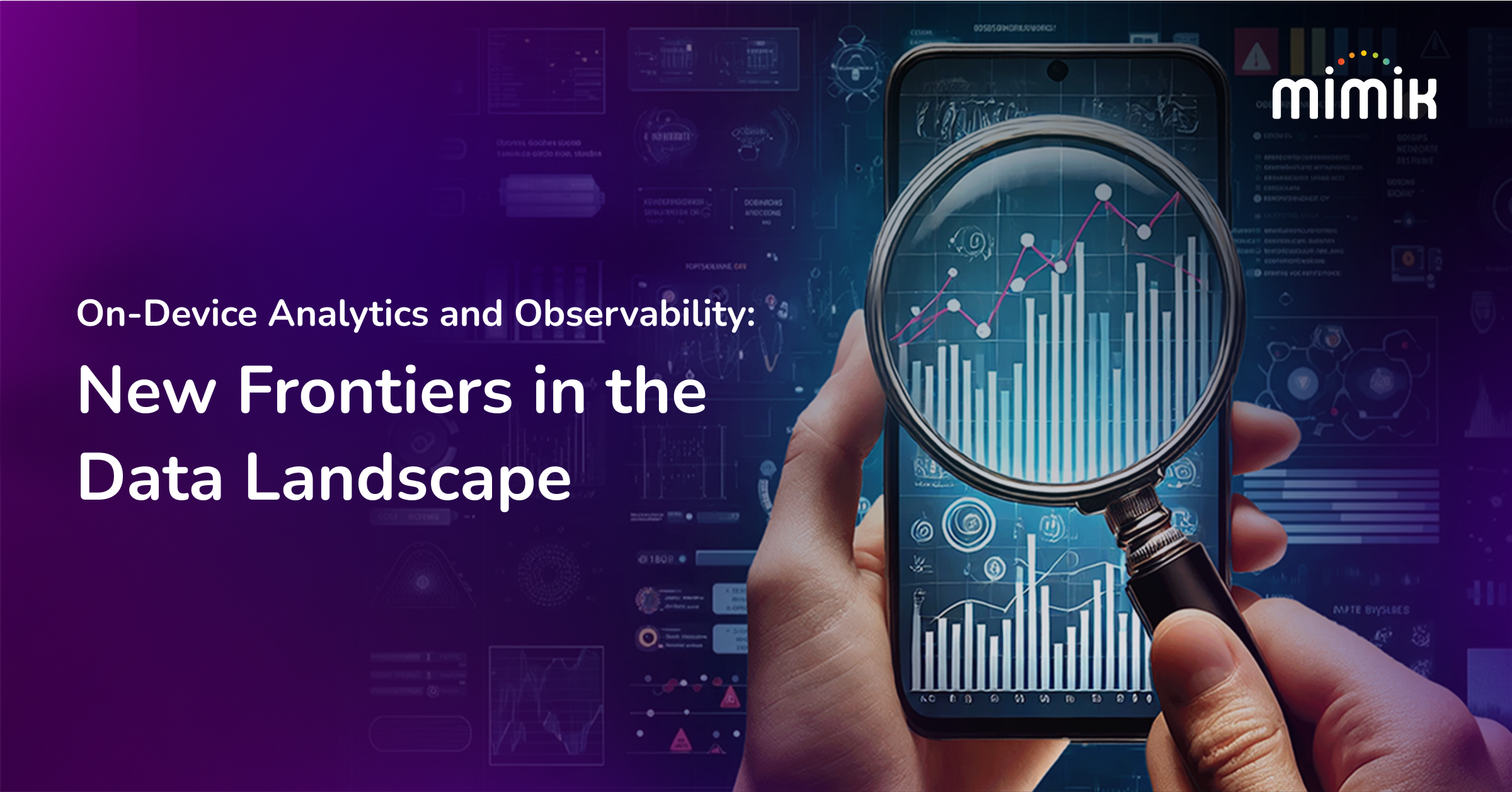Abstract:
This article explores how mimik’s edgeEngine enhances the landscape of data analytics and observability, providing tools for more precise, timely, and actionable data insights. While not an analytics engine itself, mimik’s technology significantly improves data collection and preprocessing, serving as a robust foundation for deeper analytics processing by third-party systems or higher layers within the architecture. With the increasing demand for offline-first capabilities, privacy, and security, mimik’s edgeEngine empowers analytics and observability solutions with advanced on-device processing. This approach enables the application of specific data policies, offers capabilities for staged analytics, and structures data before it is sent to different endpoints according to policy requirements. While edgeEngine does not directly deliver analytical summaries or recommendations, it empowers solution providers to build more powerful, secure, and responsive analytics systems, positioning them at the forefront of innovative data processing.
Introduction:
Imagine a world where devices are not just passively sending data but are active participants in real-time decision-making. The mimik Hybrid Edge Cloud (HEC) technology fulfills this vision. With mimik edgeEngine—a cloud-native software operating environment—applications can utilize the power of smart devices to perform real-time data processing directly on the device and securely expose the outcome via APIs to the rest of the system, ensuring that only those with the right credentials and permissions can access it. This includes providing capabilities such as an API gateway, AI agents, and microservices runtime. The mimik edgeEngine supports nearly all operating systems and can run on a variety of devices, including smartphones, tablets, cameras, microcontrollers, robots, and drones. This platform enables offline-first operations, reducing latency, ensuring data privacy, and minimizing reliance on cloud connectivity. By facilitating seamless integration and discovery of microservices workloads, including AI agents, mimik’s edgeEngine delivers a more responsive and efficient system architecture.
Transformative Power of On-Device Analytics
Imagine a car detecting a driver’s medical emergency through a wearable device. Instantly, on-device analytics processes the data, alerts healthcare services, informs emergency contacts, and coordinates with smart city traffic systems to ensure a clear path to the nearest hospital. This real-time, cross-domain system interaction exemplifies the transformative power of on-device analytics.
The Role of On-Device Analytics
On-device analytics processes data where it’s generated, offering significant advantages:
- Reduced Latency: Immediate decision-making without cloud dependency.
- Enhanced Privacy: Local data processing minimizes exposure.
- Improved Efficiency: Real-time responses and reduced bandwidth usage.
The Role of AI in On-Device Analytics
Artificial Intelligence (AI) enhances on-device analytics by enabling systems to learn from data, identify patterns, and make informed decisions. AI agents can operate on end devices where most data is generated, allowing for real-time responses to dynamic conditions. This capability is crucial in scenarios where immediate action is required whether for safety-critical applications, industrial automation, personalized user experiences, or other situations where rapid decision-making is essential, with or without internet connectivity.
AI can enhance on-device analytics through:
- Predictive Analysis: AI algorithms can predict potential issues before they occur, enabling preventive measures. For instance, AI can analyze health data from wearable devices to predict a possible cardiac event and alert medical professionals in advance.
- Real-Time Decision Making: By processing data locally, AI agents can make instantaneous decisions. This is critical in a variety of industries, including industry 4.0, manufacturing, automotive, and healthcare, where immediate responses are essential for optimizing operations.
- Personalization: AI can analyze user data to provide personalized experiences. In smart homes, AI can learn the habits and preferences of residents to optimize energy usage and enhance comfort.
- Enhanced Security: AI can detect anomalies in data that might indicate security threats, allowing for immediate action to protect sensitive information.
How Analytics Works and mimik’s Impact
Analytics involves three primary phases: Data Collection, Transport, and Consumption.
Data Collection:

Data Collection is the first critical phase of analytics, encompassing logs, metrics, and traces. Logs capture specific events, providing a detailed account of what happens within the system. Metrics measure system performance at any given time, offering insights into the system’s operational health. Traces link these events and metrics to specific system components, helping to identify and attribute occurrences accurately. mimik enhances this phase by enabling devices with a microservice runtime and API gateways, significantly increasing observability. With edgeEngine, data can be collected at multiple levels—from the operating system and platform-specific APIs to user-permitted and application-level data—ensuring a comprehensive capture of system behaviour.
- Logs: Capture specific events.
- Metrics: Measure system performance.
- Traces: Attribute events to system components.
mimik’s Added Value:
- Increased Observability: By enabling devices with microservice runtime and API gateways, mimik significantly enriches data collection. This integration increases the number of data sources, capturing more granular details about system behavior.
- Data Levels: mimik’s edgeEngine allows data collection at multiple levels (OS, platform without user permission, platform with user permission, and application level), ensuring comprehensive data capture directly from devices.
- End-to-End View: Microservices running on smart devices act as active data sources, providing a holistic view of system performance and behavior.
Transport:

Once data is collected, it needs to be transported efficiently. This phase deals with both structured and unstructured data, optimizing it for transport. On-device processing can perform advanced filtering, reducing the volume of data transmitted over networks. mimik’s platform supports on-device microservices that perform machine learning-driven filtering, ensuring that only valuable data is sent. Additionally, on-device processing enhances the semantic value of data, improving its quality before it reaches central systems. By aggregating and buffering data optimally, mimik minimizes connection requests and reduces bandwidth usage, making data transport more efficient and cost-effective.
- Data Types: Structured and unstructured data.
- Optimization: On-device filtering and caching improve efficiency and reduce costs.
mimik’s Added Value:
- Enhanced Filtering: On-device microservices can perform advanced filtering to reduce the data volume sent over the network. These filters can be machine learning-driven, ensuring only valuable data is transmitted.
- Semantic Enhancement: On-device processing can enhance the semantic value of data, improving its quality before it reaches central systems.
- Efficient Aggregation and Buffering: mimik’s platform allows for optimal aggregation and buffering, minimizing connection requests and reducing bandwidth usage.
- Structured Data Transmission: Data can be structured and enriched according to policies (security, compliance), ensuring efficient and compliant data transport.
Consumption:

The final phase of analytics is data consumption, which can occur either in real-time at the source (early consumption) or further along the data stream for aggregated business intelligence (late consumption). mimik enables microservices to process data locally on smart devices, making it actionable in real-time. This local processing enhances the semantic value of data and reduces latency, ensuring that insights are available faster. Furthermore, results from central processing can be pushed back to devices, providing minimal latency and optimal performance. This approach not only improves efficiency but also ensures that data-driven decisions can be made swiftly and securely.
- Early Consumption: Real-time decision-making at the source.
- Late Consumption: Aggregated data for high-level business intelligence.
mimik’s Added value:
- Local Processing: By enabling microservices on smart devices, mimik facilitates on-device data processing, making it actionable in real-time.
- Enhanced Data Value: Local processing enhances the semantic value of data, whether for local or central consumption.
- Reduced Latency: Results from central processing can be pushed to devices, ensuring minimal latency and optimal performance.
Enhancing Observability and Business Intelligence
On-device analytics aids in two crucial areas:
- Observability:
- System Behavior: Provides precise metrics and traces, integrating devices as active system components.
- Debugging and Optimization: Enhances understanding and management of system performance.
mimik’s Added Value:
- Behavioral Insights: By treating devices as integral parts of the system, mimik enables better insights into system behavior, helping identify issues more accurately.
- Integrated Debugging: Devices with compute capabilities become part of the system, improving debugging and optimization processes.
- Business Intelligence:
- System Usage: Offers insights into user interactions and system refinement.
- Targeting and Refinement: Improves delivery and consumption targeting based on real-time data.
mimik’s Added Value:
- Enhanced Understanding: By integrating on-device microservices, mimik provides deeper insights into system usage and performance, improving business intelligence.
mimik’s edgeEngine Capabilities
mimik’s edgeEngine provides a runtime environment for microservices, enabling real-time context and decision-making directly on devices. This leads to:
- Accurate Context: Captures real data at the source, enhancing system reliability.
- System Integration: Treats devices as integral parts of the system, not just endpoints.
- Dynamic Service Mesh: Creates an adaptable system that can expand or shrink based on local conditions.
Conclusion

mimik’s platform transforms data analytics by enabling contextual on-device operations. This brings real-time processing, enhanced security, and reduced latency directly to where data is generated. By integrating endpoint devices as integral parts of the system, mimik supports offline-first, real-time data processing and decision-making directly on the device. This approach significantly reduces latency, adheres to data privacy and sovereignty, and securely exposes outcomes via standard APIs with granular access control right from the end-device. By enabling applications to utilize the power of devices—from smartphones and tablets to drones and microcontrollers—with advanced cloud-native functionalities, mimik ensures seamless integration and discovery of AI agents and microservices workloads.
The ability to perform sophisticated analytics directly on devices paves the way for faster and more reliable decision-making across various industries, driving superior sustainability, adaptability, efficiency, performance, and user experience. mimik is not only transforming how data is processed and utilized in real time but also enabling new business models and opportunities within the Data-as-a-Service ecosystem. With mimik, the future of intelligent systems lies in the seamless and efficient management of data, driving innovation and unlocking unprecedented value on-device.



